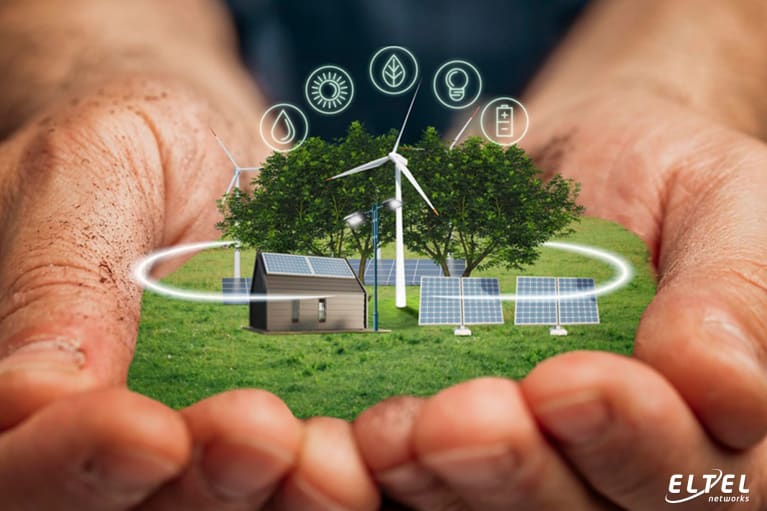
Electricity microgrid
The development of renewable energy sources and modern technologies related to energy storage (e.g., 3S electricity storage) has led to changes in the approach to grid design. One innovative component that is an alternative to traditional grids is microgrids. What are they, what is the design of microgrids, and what impact do they have on the economy?
Microgrid - what is it?
Microgrid - as the name suggests is a small power grid that is separate and independent from the traditional power grid, although it can be connected to it. It can operate in island mode or in grid-connected mode. A microgrid uses renewable energy sources, among other things, to generate electricity. The grid itself combines a number of elements to optimize production, energy use or energy storage. Unlike traditional grids, microgrids generate energy locally rather than centrally, which affects their operation.
What makes up a small-scale power grid??
A microgrid is an organized set of energy systems that consists of several basic elements. Among these are:
- energy generation systems - these include solutions such as photovoltaic farms, solar panels, wind turbines, fuel cells, heat pumps and other energy sources - often RES
- energy storage systems - these include a variety of energy storage solutions, such as lithium-ion battery systems, 3S electricity storage (SunSmartStore) equipped with a power management system that greatly improves the operation of photovoltaic or wind installations, fuel cells and others
- the energy distribution system - energy distribution is a key element from the point of view of microgrid customers, since, due to its local nature, extensive substations are not needed for its distribution
- control of the microgrid - the system responsible for controlling the operation of the microgrid is designed to monitor and manage the state of the network in order to maintain the balance of electricity and proper parameters, optimize the performance of the microgrid or control the cooperation with the distribution network operator
Advantages of microgrids
The concept of microgrids has developed rapidly in recent years referring to the challenges of ensuring an energy supply that meets growing demand, as well as the need to diversify sources of power generation. The development of this idea is due, among other things, to a number of advantages of microgrids. These advantages exist both for energy consumers and grid users, as well as being of a more global nature.
Above all, a small, local power grid guarantees increased energy security, allowing supplies to be maintained even in emergency situations. This is an important advantage from the point of view of grid users. However, it also has a broader significance, because in the face of significant congestion on the national power system, microgrids also provide facilities that enhance security and facilitates the stability of the entire system.
In addition, microgrids, making significant use of renewable energy sources, allow for more environmentally friendly energy production, which also has a positive impact both locally and globally. From the perspective of a country like Poland, widespread implementation of microgrids can allow the economy to reduce its dependence on fossil fuels.
Another advantage is minimizing energy losses. With traditional central systems, transmission losses can be a significant challenge. In contrast, in a small grid situation, the problem of distance disappears, significantly reducing the level of transmission losses by dispersing energy.
Among the primary advantages of designing, implementing and using a microgrid, it is also worth noting the cost reduction. A microgrid can significantly reduce the amount of energy sourced from an external supplier, which reduces the cost of purchasing energy. This is particularly effective when using solutions that allow optimization in this regard. What's more, the surplus electricity generated can even provide an additional source of income through their sale to the grid.

How do you design a microgrid?
Microgrid design
What is the process of designing and implementing microgrids? Of course, it depends on the scale of the investment and its scope. However, there are several elements that are quite universal for different types of projects. First of all, it is necessary to estimate the energy demand of the consumers or users of the designed microgrid. At the preparatory stage, it is also necessary to take into account the availability or applicability of various solutions that allow the use of renewable energy sources. It is also necessary to conduct an audit of the functioning power equipment or availability of energy in the traditional model.
The next step in this process is the preparation of the concept of operation and configuration of the designed microgrid. It must include such elements as potential interconnection with the distribution grid operator, take into account all the grid components mentioned above, such as energy storage, as well as detailed assumptions for managing the entire grid. The implementation process is complex and multi-stage, but it should not be forgotten that the benefits of a microgrid are also important.
Microgrids - summary
Although the concept of microgrids is relatively young, it can be said that it is no longer just the future, but is actually becoming the present. It is to be expected that microgrids will become increasingly important in the years to come, given the challenges facing the power sector. As the list of potential advantages shows - this will be to the benefit of both microgrid users and at the macro level.
